
Sex ratio in CAR is 105 in 2020
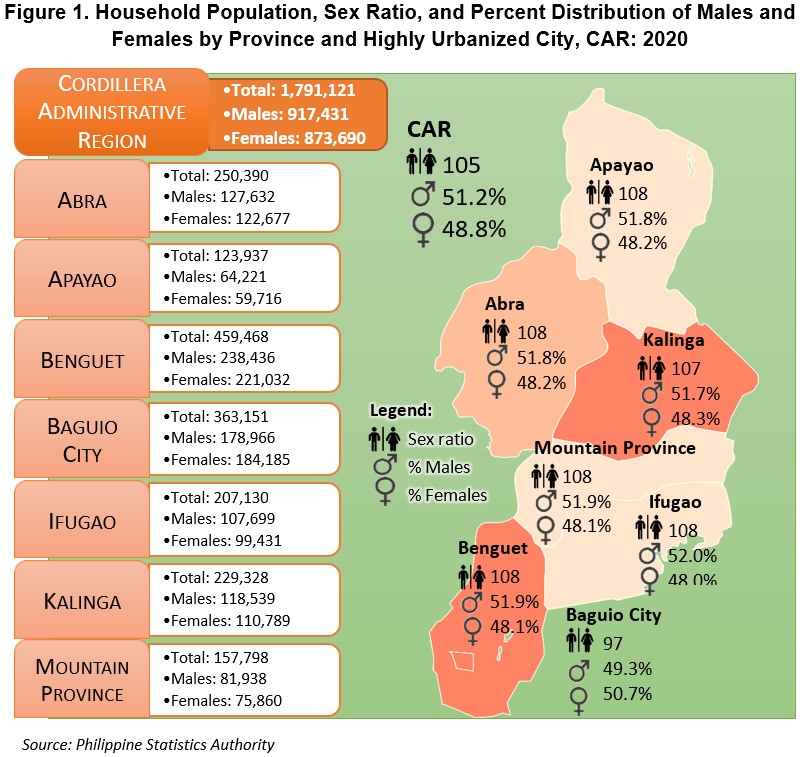
There were more males than females in the Cordillera Administrative Region based on the results of the 2020 Census of Population and Housing. Particularly, there were 105 males for every 100 females in the region. Of the household population of 1.79 million, 48.8 percent were women, equivalent to 873,690 individuals (Figure 1).
There were also more men than women in all provinces in the region, with exception to Baguio City with sex ratio of 97. In Abra, there were four more males for every 100 females in the household population in the province. Kalinga recorded a sex ratio of 107, while the rest of the provinces registered sex ratios of 108 in each.
Out of the 363,151 population in Baguio City, 50.7 percent or 184,185 individuals were women. This was the only area in the region with more women than men in the population, although geographically situated in the province of Benguet. In contrast, there were more males in Benguet province with 238,436 individuals or 51.9 percent of its household population of 459,468 persons.
Among provinces with male-dominated population, Ifugao province had the least share of women in the population with 48.0 percent of 207,130 household population. Mountain Province followed with 48.1 percent or 75,860 women in their population of 157,798 persons. Apayao had the least count of women with 59,716 individuals out of 123,937 persons in the province.
Apart from Baguio City and Benguet, the provinces of Abra and Kalinga reported above 100-thousand count of women in the household population. There were 122,677 females in Abra that comprised 49.0 percent of its population in 2020. Meanwhile, there were 110,789 women in Kalinga province who shared 48.3 percent of its total inhabitants.
Sex ratio declines among 60 years old and over
Across five-year age groups, sex ratios in the region were above 100 from 0 to 59 year-old individuals. This began to decline in the age group 60 to 64 years old at 97 males per 100 females. This gradually decreased as the age went higher, with sex ratio of only 55 males per 100 females among persons 80 years old and over. (Table 1)
The population with significantly greater number of men compared to women were found among age groups 30 to 44 years old, with sex ratios at 110 and above. The highest among these were in the ages 35 to 39-year-old persons, with 112 males per 100 females. This was closely followed by persons in the age groups 40 to 44 years old and 30 to 34 years old with sex ratio of 111 and 110, respectively.
The decline of sex ratio below 100 among 60 years old and over in the region was also similar in the provinces of Abra, Ifugao and Kalinga. This was later by 5 years in the provinces of Apayao and Benguet, where there were more females starting among 65 years old persons and older. In Mountain Province, the decline was moved further by 10 years as there were more women in the population among 70 years old and over individuals.
In Baguio City, sex ratios below 100 were seen among individuals aged 20 to 34 years old, and began to gradually declining from 40 years old and over. One age group had more males than females in between these age ranges, specifically among 35 to 39-year-old individuals, with 101 males over 100 females.
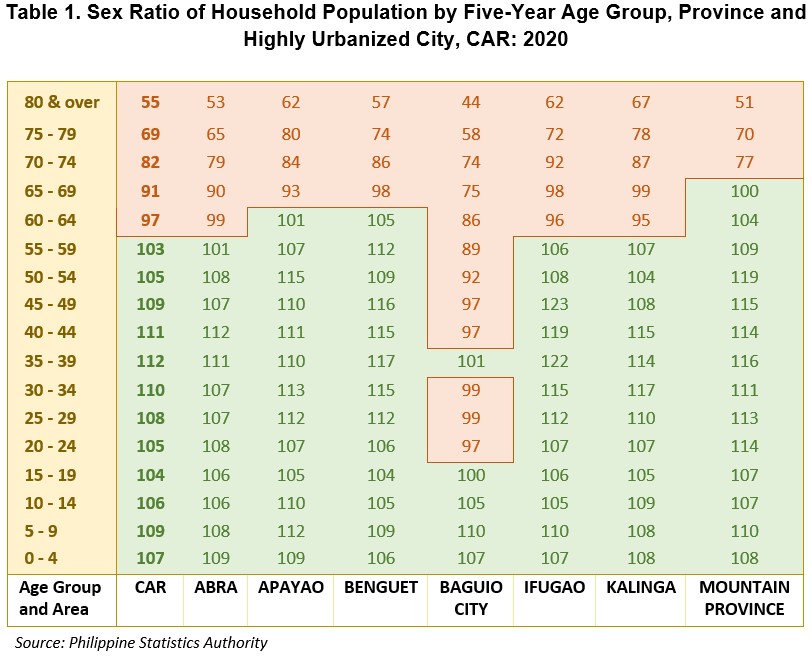
The under five-year old persons in the population was male dominated in CAR and all provinces in the region. This was consistent until 15 to 19-year-old population across all areas, except in Baguio City wherein sex ratio was 100 in this age group.
Women dominate working age population in Baguio City
The working age population in the region, or persons aged 15 to 64 years old, were recorded at 1.18 million in 2020 (Figure 2). In this population, 569,504 or 48.3 percent were women. This translated to sex ratio of 107 males over 100 females. Working age persons in the provinces were also male-dominated, with exception in Baguio City with sex ratio of 97 in this age group.
Meanwhile, among the school age population aged 5 to 24 years of 699,047, 48.5 percent or 339,139 were women. This age group was still male dominated with sex ratio of 106 in the entire region and in all provinces and in the lone HUC. Of the total female school age population, 44.8 percent were in Baguio City and Benguet with a total of 151,981 persons.
The total number of women under the reproductive age (females aged 15 to 49 years old) in the region was 464,847 individuals. About 48.4 percent of these women were in Baguio City and Benguet with a combined total of 224,867 individuals. The lowest number recorded was in Apayao with 30,993 women of reproductive age.
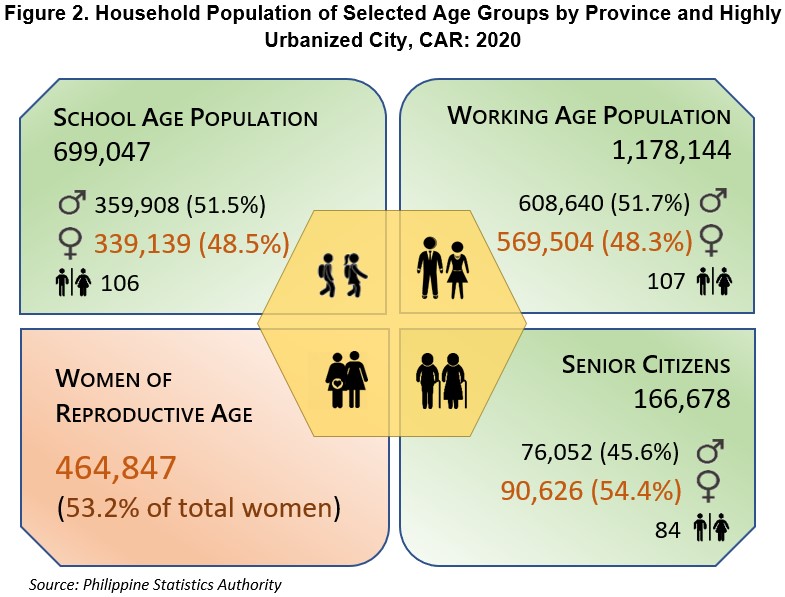
Senior citizens in the region, on the other hand, were recorded at 166,678 in 2020. There were about 54.4 percent of them who were females, and this translated to sex ratio of 84 senior men in 100 senior women in the region. Abra registered the least sex ratio among seniors with 82 men over 100 women, while there were 90 senior men per 100 senior women in Benguet.
There is nearly an equal share of overall dependency between men and women
The overall dependency ratio of CAR household population was 52 in 2020 (Figure 3). This means there was a total of 52 young (under 15 years old) and old dependents (65 years old and over) for every 100 working age individuals (15 to 64 years old) in the region. In this ratio, 26 were male dependents and 26 were female dependents.
The total count of dependents in CAR population was at 612,977 persons. About 50.4 percent of these individuals were males or 308,791 persons while 49.6 percent were females or 304,186 persons. The total dependents were 34.2 percent of the total household population in the region.
Out of the dependency ratio, there were nine (9) old dependents per 100 working age persons. Among the old dependents, 4 were males while 5 were females. This was based from the total population of old dependents of 107,820, wherein 43.6 percent were males and 56.4 percent were females.
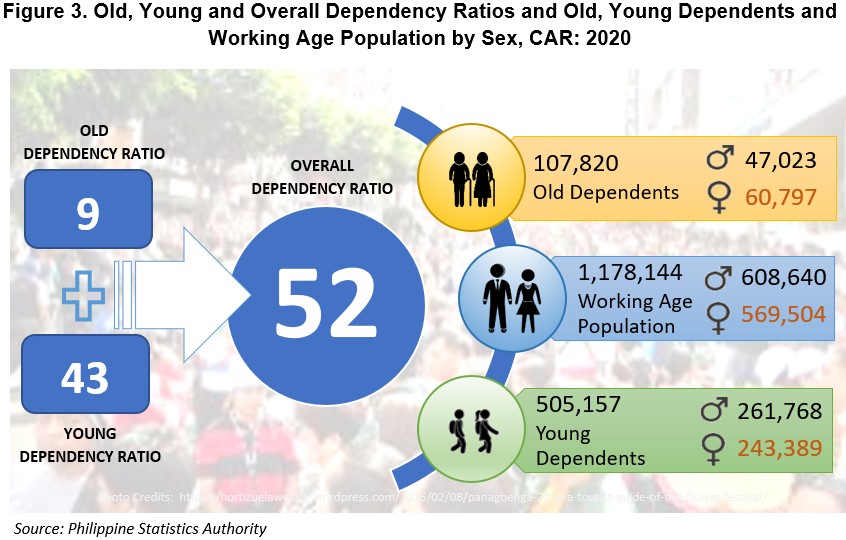
Young dependents meanwhile were 43 persons per 100 working age individuals. This was comprised of 22 male young dependents and 21 female young dependents. This was computed from a total count of 505,157 young dependents in the household population, wherein 51.8 percent were males and 48.2 percent were females.
Aging index of males is 3 points lower than females
CAR had an aging index of 33 in 2020, meaning there were 33 senior citizens per 100 young dependents. This was based on 166,678 persons 60 years old and over and 505,157 persons under 15 years of age. Of the regional aging index, there were 15 males and 18 females.
In general, the aging index among areas in the region were dominated by females. Abra had the highest aging index at 43 older persons per 100 young persons in the population of which 19 were males and 24 were females. This was followed by Baguio City with aging index of 38, composed of 16 older men and 22 older women.
In Mountain Province, there were 35 older persons for every 100 young individuals in the province. Among these older persons, 16 were males while 19 were females. This was followed by Kalinga where the aging index was 29 with 14 older males and 15 older females.
Provinces with the least aging index were Benguet and Ifugao, both with 28 older individuals per 100 young population. Also in both provinces, these were composed of 13 older men and 15 older women.
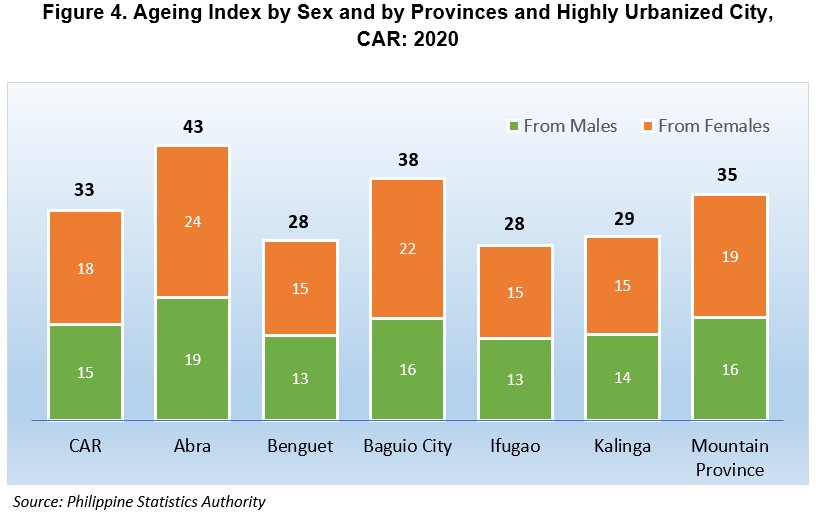
Among ever-married persons, 51.4% are women
In the household population 10 years old and over in CAR of 1,461,709, there were 60.1 percent who were ever-married equivalent to 878,007 individuals. Of these persons, 51.4 percent or 451,280 were females while 48.6 percent were males.
There were 793,265 currently married persons in the population, wherein 82.7 percent were in marital union while 17.3 percent were in common law or live-in arrangement. Out of 656,315 married persons, 50.6 percent were men and 49.4 percent were women. Meanwhile, those in common law marriages were 136,950 persons, wherein 51.9 percent were males and 48.1 percent were females.
Out of the ever-married persons, 84,742 persons have no current partners. About 3 in 4 of these persons were widowed, equivalent to 63,980 individuals. Among them were 14,768 widowers (23.1 percent) and 49,212 widows (76.9 percent).
On the other hand, 20,762 persons were divorced, separated or whose marriage were annulled. Two in five of these individuals were women while 3 in 5 of them were men. These persons who severed ties with their previous partners were 1.4 percent of the household population 10 years and over.
Among the 583,642 never-married individuals, 54.7 percent were men while 45.3 percent were women. There were also 60 persons in the population who did not report their marital status, wherein 3 in 10 were men and 7 in 10 were women.
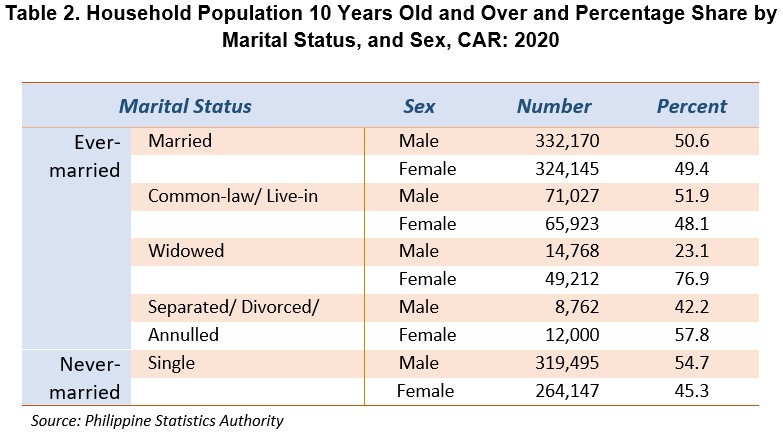
1 in 10 women in common-law marriages is younger than 20 years
Some young women in CAR married before they reach 20 years of age, with 1.4 percent of the total married women in 2020 (Table 3). In addition, 1.0 percent of married men were also in this young age group. Among women in common-law marriages, about 9.7 percent were younger than 20 years. There were also 5.2 percent among men who were this young and have already entered live-in arrangement.
There was 1 in 2 women in marital union (52.8 percent) in the region who was of age 35 to 59 years old. The share among married men was slightly higher at 55.7 percent in the same age group. This was followed by married women 20 to 34 years old with share of 31.4 percent. Among men, there was 1 in 4 married persons who were in the same age group (25.7 percent).
Majority of younger adults, aged 20 to 34 years old, were into common-law marriages or live-in unions. The share of women was 55.2 percent while men was at 53.9 percent. This was followed by persons of age 35 to 59 years for both genders, with 29.1 percent among women and 34.8 percent among men.
Most widowed individuals were of age 35 years and over, wherein there were 98.1 percent of them among widows and 97.9 percent among widowers. A small share of widowed persons was seen among persons below 20 years of age in 2020, with 0.1 percent and 0.2 percent among women and men, respectively.
High rates of individuals with divorced, separated and annulled marriages were reported among women and men 35 to 59 years old, with 60.1 percent and 66.8 percent, respectively. This was followed by women in the age group 20 to 34 years old with 24.3 percent, while in men this was followed by those in the age group 60 years old and over with 16.5 percent.
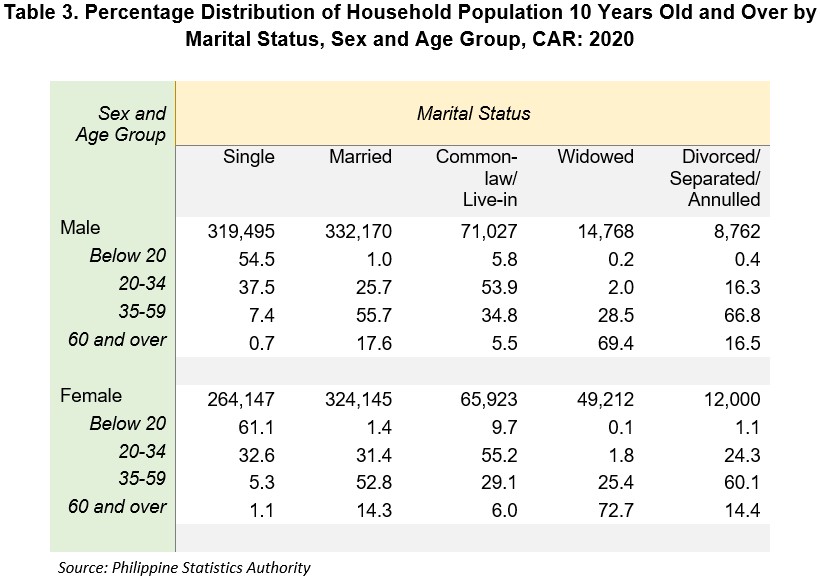
There were recorded widowed persons among individuals younger than 20 years, with 0.1 percent among women and 0.2 percent among men. Meanwhile, there were also persons in this age group who have already divorced, separated or whose marriages have been annulled, with 1.1 percent among women and 0.4 percent among men.
Most of individuals who have never married were younger than 35 years in 2020. Among single women, 61.1 percent were below 20 years old while 32.6 percent were 20 to 34 years old. However, among single men, 54.5 percent were younger than 20 years while 37.5 percent were of age 20 to 34 years old.
VILLAFE P. ALIBUYOG
Regional Director
_________________________________________
Technical Notes
Household is a social unit consisting of person or a group of persons who sleep in the same housing unit and have a common arrangement in the preparation and consumption of food.
Household population refers to all persons who are members of the household.
Sex is the biological and physiological reality of being a male or female.
Age refers to the interval of time between the person’s date of birth and his/her last birthday prior to the census reference date. It is expressed in completed years or whole number.
Sex ratio is the number of males per one hundred females in a population.
Overall dependency ratio is the number of persons under 15 years old (young dependents) and persons aged 65 and older (old dependents) per one hundred persons 15 to 64 years old (working-age or economically-productive group) in a population.
Aging of population is a process in which the proportions of adults and elderly increase in a population, while the proportions of children and adolescents decrease. This process results in a rise in the median age of the population. Aging occurs when fertility rates decline while life expectancy remains constant or improves at the older ages.
Aging index is calculated as the number of persons 60 years old and over per one hundred persons under the age of 15 years.
Marital status refers to the personal status of an individual in accordance with the marriage laws or customs of the country. It is the same as civil status, the term usually used in official and private records, documents, and transactions in the country. The person’s marital status shall be as of the date of visit. The categories of marital status are as follows:
a) Single – a person who has never been married;
b) Married – a person married in a religious, civil ceremony or tribal rites, either living with his/her spouse at the time of visit or temporarily living apart because his/her spouse is employed elsewhere (as in the case of a person whose spouse is an overseas worker, or works in the Armed Forces and residing somewhere else);
c) Common-law/Live-in – a person cohabiting or living consensually with another person as husband and wife without the benefit of a legal marriage;
d) Divorced – a person who is permanently separated from his/her spouse, legally or through mutual consent; also applicable for a person whose marriage with another person has been annulled or dissolved and can, therefore, remarry;
e) Widowed - A person whose bond of matrimony has been dissolved by death of his/her spouse. and
f) Unknown – a person whose marital status is unknown to the respondent or whose marital status is being concealed by the respondent/person himself/herself.
More data and related tables can be found in the PSA Website: https://psa.gov.ph/population-and-housing.

